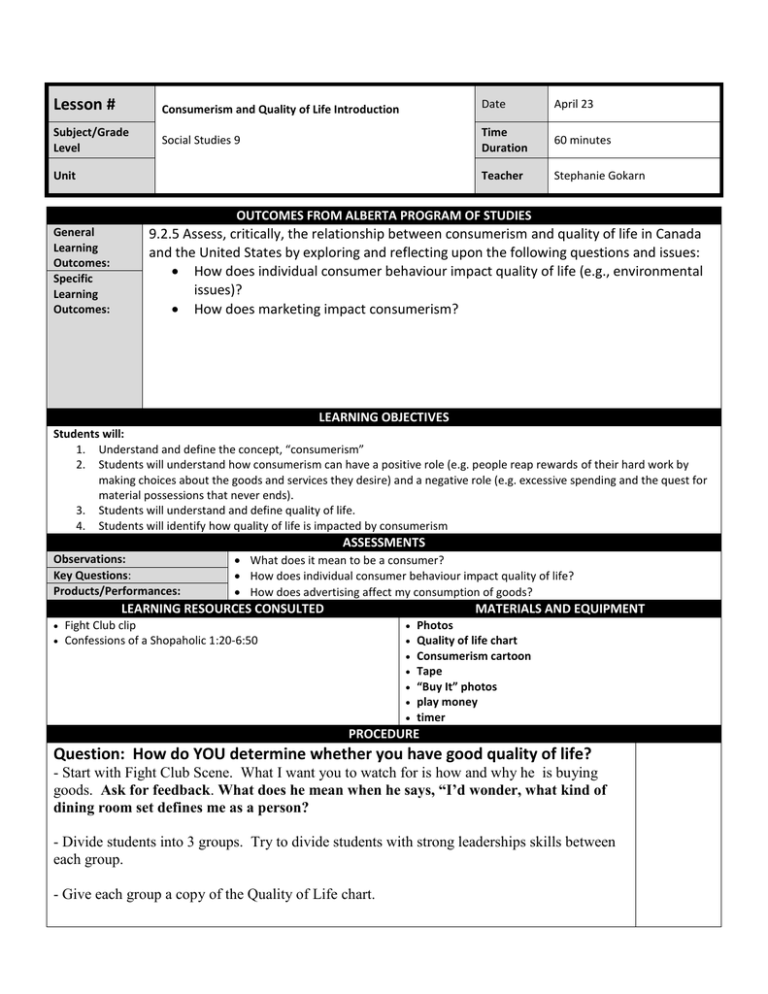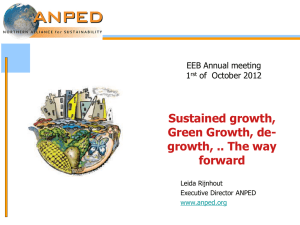Consumerism, Grade 9
advertisement

Lesson # Consumerism and Quality of Life Introduction Date April 23 Subject/Grade Level Social Studies 9 Time Duration 60 minutes Teacher Stephanie Gokarn Unit OUTCOMES FROM ALBERTA PROGRAM OF STUDIES General Learning Outcomes: Specific Learning Outcomes: 9.2.5 Assess, critically, the relationship between consumerism and quality of life in Canada and the United States by exploring and reflecting upon the following questions and issues: How does individual consumer behaviour impact quality of life (e.g., environmental issues)? How does marketing impact consumerism? LEARNING OBJECTIVES Students will: 1. Understand and define the concept, “consumerism” 2. Students will understand how consumerism can have a positive role (e.g. people reap rewards of their hard work by making choices about the goods and services they desire) and a negative role (e.g. excessive spending and the quest for material possessions that never ends). 3. Students will understand and define quality of life. 4. Students will identify how quality of life is impacted by consumerism ASSESSMENTS Observations: Key Questions: Products/Performances: What does it mean to be a consumer? How does individual consumer behaviour impact quality of life? How does advertising affect my consumption of goods? LEARNING RESOURCES CONSULTED MATERIALS AND EQUIPMENT Fight Club clip Confessions of a Shopaholic 1:20-6:50 Photos Quality of life chart Consumerism cartoon Tape “Buy It” photos play money timer PROCEDURE Question: How do YOU determine whether you have good quality of life? - Start with Fight Club Scene. What I want you to watch for is how and why he is buying goods. Ask for feedback. What does he mean when he says, “I’d wonder, what kind of dining room set defines me as a person? - Divide students into 3 groups. Try to divide students with strong leaderships skills between each group. - Give each group a copy of the Quality of Life chart. - Have students analyze and discuss the photos. - Using what you know, or what you think you know about quality of life, students will choose which of the three photos that they think shows the highest quality of life and give supporting reasons for each (in one – three words). Try to come to a consensus. If you don’t agree, explain why. - Have class come back together. - How did you base your decisions? How did you choose between them? What are the characteristics that you based your decisions on? - List characteristics on the board. See if they can see a pattern emerging from their answers. - Discuss, as a class, why the groups had such similar results (assuming they did). 9: - So what is quality of life? In your groups, discuss and come up with a definition. Write it down. - Share definitions. Can we come up with a group one? *********************************************************************** - Show Shopaholic clip - What is her perspective on buying? How does she consume goods? Does she have a high quality of life? Now that we’ve defined Quality of Life, let’s move on. (Don’t mention consumerism yet). BUY IT!! You have all just graduated from university and are living on your own. Each person is given $2000 of play money to spend. YOU CANNOT SPEND MORE THAN YOUR $2,000. IF YOU DO, SOMETHING HAS TO GO BACK BEFORE WE MOVE ON TO MONTH TWO. From the picture list, students are to spend as much of their $2,000 as they can in 1 minute. * The purpose of doing it quickly is to have them follow their instincts to make choices. They can make their own judgements about what is important enough to buy. Done individually. -When time is up, students share with their groups what they chose to buy. Listen to discussion then have a large group one briefly. Ask a few students, “Why did you make these choices? How did you decide what was important to have?” - The next round represents one month later. Students still have $2,000, plus whatever was left over. They can buy as much as they can in 1 minute, but this time they must choose to replace two of the items already on their list for upgrades. - After 1 minute, ask students about their choices. Did they choose differently? Was it harder now that they were more limited in their choices? - *Can add more rounds if time permits. - Introduce the concept “consumerism”. What do you think it means? - Centre discussion around their choices. How could they live/survive off the choices they made? Do their choices make their lives better? How so? - How do these choices affect the environment? The economy? - In your groups, try to determine how consumerism can be both a positive and a negative thing. Can they come up with examples? Show illustrations from SEE-I if time permits. - Exit slip: How are consumerism and quality of life different? Quality of life: The general well-being of a person or society, defined in terms of health and happiness,rather than wealth. Example: Poor quality of life: being sick with terminal cancer. Full quality of life: healthy relationships, stable job, good home. Social, political, economic, physical Sometimes people confuse quality of life with consumerism Sponge Activity/Activities Reflections from the lesson Quality of life chart Compare these rooms. Choose the ones you like best from each column and list 3 ways that you think the quality of life is better in that photo. Option One Option Two Living room – Living room – Kitchen – Kitchen – Back yard – Back yard – SEE-I State it: Consumerism: Positive definitions: 1) Advocacy of a high rate of consumption and spending as a basis for a sound economy. 2) The ability of people to reap the rewards of their hard work by making choices about the goods and services they desire. Negative definition: Excessive spending and the quest for material possessions that never ends. Elaborate: Consumerism is a relatively new concept that can have multiple meanings and connotations. Students should be examining the concept of consumerism in relation to quality of life. They should look at how it can be a positive idea, and create a thriving economy, and higher levels of personal comfort. They should also examine how it can negatively affect the individual and society – the environment, waste, a continual search for happiness through material possession, etc. Exemplify: Negative: Seeing a commercial on tv for a 60” LED tv and deciding to purchase it, even though you have a working 50” tv already. Positive: The economy depends on people buying stuff. More consumption requires more production, which leads to more jobs and greater economic prosperity for the individual and society. Ethically-based products is another example. Illustrate: Positive consumerism Negative consumerism BUY ME!! $1000 $600 $800 $50 $1000 $200 $400 $200 $200 $300 $60,000 Lease: $800 $700 $100 $600 $300 $500







